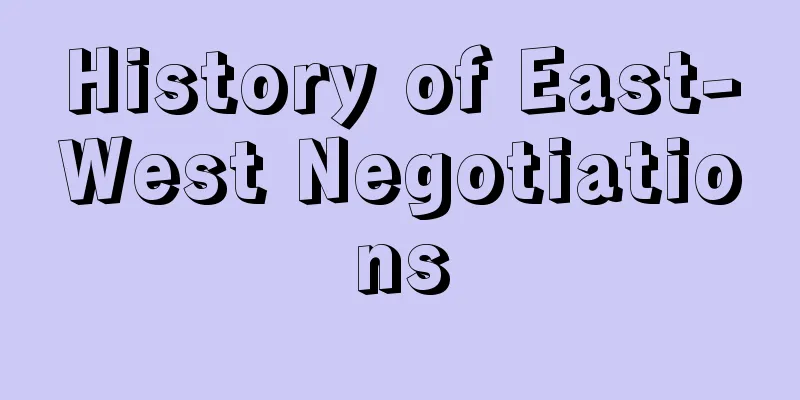History of East-West Negotiations

|
A field of history that examines the relationship between the East and the West in world history, particularly the history of the Eurasian continent. "East" refers to East Asia (China), and "West" refers to Western Asia (mainly Iran) and the adjacent Mediterranean region to the west, the Roman Empire, and, depending on the period, Europe as well. It also includes negotiations via the Indian subcontinent. Research subjects include transportation, political contact, and commercial activity between the East and West, as well as the associated cultural spread, exchange, and acceptance. [Toru Saguchi] Functions and StructureThe two great civilizations of East Asia/China and West Asia are heterogeneous and geographically very far apart. Moreover, between them are arid regions including high mountain ranges, barren deserts, oasis farmland, and even grasslands, making transportation between the two worlds extremely difficult. However, since prehistoric times, merchants who yearned for the rare products of faraway foreign lands and sought profits risked their lives to travel to the far east and west of the world. However, it was difficult for them to reach their destinations themselves, so in such cases nomads and oasis residents in the intermediate regions acted as intermediaries. This was the origin of relay commerce, in which not only goods but also culture were relayed. This was the basic form of East-West exchanges. The routes of exchange were mainly land routes through Central Asia and sea routes via seaports in Southeast Asia, India, and Iran. Although there were ups and downs in different periods, land traffic was generally stable. Items of trade between the East and West were rare local products and luxury goods for the upper classes, such as Chinese silk, ceramics, tea, Southeast Asian spices, Siberian furs, and Central Asian gems (such as rubies), as well as glassware, metalware, and woolen fabrics from the West, with Chinese silk and Southeast Asian spices being especially prized in the West. These goods were often traded through oases residents along the East-West routes. In terms of cultural exchange, things that were transmitted from the West to the East were prominent, such as Buddhism in India, Zoroastrianism, Manichaeism, Nestorian Christianity, Islam, and the spread of Roman Catholicism to the East in Iran. It is said that papermaking techniques, gunpowder, and compasses were transmitted from China to the West. Furthermore, in the field of East-West exchanges, there are also forms of negotiation, contact, and a combination of these due to wars of conquest and migration of peoples. In Eurasia, the invasion of Europe by the Huns in the 4th century, the advance of Islam into the Iberian Peninsula in the 8th century, the migration of the Turks to Central and Western Asia from the 9th century onwards, the Mongol expedition to the west in the 13th century, and the subsequent advance of the Ottoman Empire into Eastern Europe were all examples of exchanges that took place from East to West. Conversely, examples include Alexander the Great's eastern expedition, the Crusaders' expedition to Syria, and Russia's conquest of Siberia from the 16th century onwards. In this way, the East and West of the world have greatly influenced each other politically, ethnically, and culturally due to migration of peoples. The history of East-West relations is a branch of history that examines the various aspects of contact, exchange, diffusion, and transformation of politics, economics, ethnicities, and cultures between East and West, and also places emphasis on the relay role of intermediate local communities between the two great civilizations of East and West. [Toru Saguchi] Main RouteThe role of transportation routes was important because East-West negotiations were triggered by transportation, cultural exchange, and transit commerce between the distant regions of East Asia, West Asia, and the Mediterranean world. There were two routes, land and sea, and the land route had two main routes with branch routes branching off from them. (1) Central Asia Route Since B.C., this route connected oasis cities in the Western Regions from China to West Turkestan, Iran, Syria, and the eastern coast of the Mediterranean (the Roman Orient). Scholars call it the "Silk Road" because it was the route along which Chinese silk, a specialty of China, was transported to Rome. It was a major overland route that was widely used for East-West transportation. The route that starts from Dunhuang on the Chinese border, runs along the northern edge of the Tarim Basin, passing through Gaochang and Qucha before reaching Kashgar, is called the Northern Tianshan Route, while the route that runs along the southern edge of the basin, the northern foothills of the Kunlun Mountains, passing through the Lop Nur region, Yuten (Hotan), and Yarkand before reaching Kashgar, is called the Southern Tianshan Route. From Kashgar, it crossed the Pamir Mountains, passed through Samarkand and various parts of Iran, reached the eastern coast of the Mediterranean Sea, and then traveled westward by sea or overland through Asia Minor to reach the Roman Empire. This route was known in the 2nd century BC by Zhang Qian's westward travels, and is described in detail in the Western Regions section of the Book of Han. It was the central route of the Silk Road, and is also called the "Oasis Route." The route that ran northwest from Samarkand around the Aral Sea and the Caspian Sea to the Volga River and the Black Sea was a secondary route. The Tarim Basin was often placed within the sphere of influence of China, and Western Turkestan was an Iranian territory in ancient times, and later became the territory of the Turks. The western half of the Silk Road was first developed by Alexander the Great's eastward expedition, and the Hellenistic world emerged along with it. This route was used by the arts and culture of the Roman Empire, the Achaemenid Empire and Sassanid Persia, as well as the religions of West Asia, especially Islam, to reach China, and during the Mongol Empire it functioned as a main route closely linking China and West Asia. Marco Polo also walked this route on his way to the Yuan Dynasty. A branch of this route was developed from the southeast Pamirs to North India, and this became the route by which ancient Buddhism spread eastward. (2) North Asian Grassland Route The transportation route that ran from east to west through the grassland regions of North Asia, including Mongolia, Dzungaria, and Kazakhstan, especially the grasslands at the northern foot of the Tianshan Mountains, has played an important role since ancient times. This region was inhabited by nomads, and was convenient for horseback riding and caravan travel except during the harsh winter months, and was the safest route for transporting goods as long as the country was politically stable. From the 5th century BC onwards, it was via this route that metal tools (weapons and ornaments) from the Scythians who lived in the grasslands north of the Black Sea were transmitted to North Asia. North Asian nomads such as the Xiongnu, Turks, and Uighurs obtained Chinese silk and resold it westward, or made a profit by exporting Siberian furs westward. During the Mongol Empire, Prano Carpini and William Ruburg traveled along this steppe route from Europe to the Mongol court in Karakorum, Mongolia, and round trip, and Marignoli also traveled along this route to Dadu (Beijing). (3) Maritime Routes During the Han Dynasty, coastal routes were established from southern Chinese ports along the Indochina Peninsula, passing through ports in Southeast Asia and reaching the coast of India, and there were also sea routes from the west coast of India to the Red Sea and the Persian Gulf. Merchant ships arrived in China from Southeast Asia under the names of Kunlun ships (Malay black ships), Persian ships from Iran, and Brahman ships from India. These sea routes were not very different from the modern sea routes between China and Western Asia via the Indian Ocean. However, in ancient times, when shipbuilding and navigation techniques were underdeveloped, maritime traffic was dependent on weather conditions, and sailing was not necessarily safe. In the 1st century BC, the Roman Empire developed the Red Sea route and promoted trade with India and China from this direction. The ocean from the Red Sea to the Indian Ocean is called the Erythraean Sea in Roman documents, and a guidebook called the Periphery of the Erythraean Sea was written, which describes the actual state of trade at that time. Ancient India developed sea routes to Southeast Asia, sent immigrants, and established Buddhism and Hindu culture. [Toru Saguchi] Development of East-West NegotiationsFrom the 2nd century BCE, there was cultural exchange between China and the Iranian world, and Indian Buddhism and West Asian culture and thought were introduced to China during the Han, Northern and Southern Dynasties, Sui and Tang dynasties. The Sui and Tang empires had a global reach, and the spread of Sassanid Persian and Central Asian cultures to China was remarkable. North Asian nomadic nations such as the Turks and Uighurs also played a role in the cultural exchange between China and West Asia. The Western Turks briefly had diplomatic relations with the Byzantine Empire. From the 7th to 8th centuries, an Islamic empire emerged in West Asia, conquered Persia, and advanced into West Turkestan, leading to the collapse of the Tang Empire in the early 10th century. Furthermore, the Turks of North Asia migrated to Central Asia and established Turkestan. This marked a new phase in East-West negotiations, with contact between China and West Asia and the Islamic world. Islamic merchants came to China by land and sea routes, and in particular almost monopolized maritime trade rights, which led to the prosperity of southern Chinese port cities, including Guangzhou, and also served as a catalyst for the introduction of Islam to China. In Western Turkistan, Islamic Turkic dynasties rose and fell, and trade with East Asia was not prominent. On the other hand, the European Crusades, which began at the end of the 11th century, clashed with Islamic forces on the eastern shore of the Mediterranean Sea, and stimulated negotiations between medieval Europe and Western Asia. Islamic civilization had a huge influence on Europe. In the 13th and 14th centuries, the Mongol Empire emerged, and close exchanges were seen from East Asia through Western Asia to Russia, Rome, and Europe, and all sorts of aspects and problems in the history of East-West negotiations unfolded. After the collapse of the Mongol Empire, East-West traffic declined, and especially in the 15th century, the Ottoman Empire emerged and hindered direct negotiations between Europe and Western Asia, so Europeans began to aim for East Asia and India by other routes. At the end of the 15th century, a route to America and a route to India via the southern tip of Africa were discovered. In particular, the Portuguese, Spanish, Dutch, and then the British and French reached East Asia directly via the Indian Ocean route, and East-West negotiations gradually took on the appearance of direct negotiations by sea. However, the Central Asian route did not decline; as the Muscovite state and then the Russian Empire developed eastward, trade between Russia and Central Asia flourished, and the Siberian route was newly developed, beginning contact between Russia and East Asia. East-West negotiations in the 18th and 19th centuries progressed in the form of European powers advancing into and dominating Asia, and maritime routes became the mainstream. [Toru Saguchi] The End of East-West NegotiationsThe term "history of East-West negotiations" was coined by Japanese scholars of Oriental history, and was not widely used by European or Chinese scholars. Here, the East refers to the Orient, i.e., the East Asian world with China at its center, and the West is thought to include Western Europe, the Roman Empire (Byzantium), and Western Asia (the Orient, Iran), but the Chinese, who considered themselves the center of the world (China), had no concept of East-West negotiations. Chinese monarchs and ruling classes longed for rare goods and advanced cultural artifacts from faraway lands in the West, and sought them out. For this reason, great Chinese merchants and Western caravans traveled actively between the East and the West, trading rare goods. The Japanese scholars who positioned this kind of cultural exchange through relays between the East and the West as a historical phenomenon and made intensive contributions to its research were Shiratori Kurakichi, Kuwahara Jitsuzo, Fujita Toyohachi, Haneda Toru, Maejima Shinji (1903-1983), Haneda Akira (1910-1989), These 20th century scholars of Oriental history included Matsuda Hisao (1903-1982), Enoki Kazuo (1913-1989), Saguchi Toru (1916-2006), Sato Keishiro (1919-2005), Yamada Nobuo (1920-1987), Mori Masao (1921-1996), and Nagasawa Kazutoshi (1928-2019). The Silk Road view of history is a unique field of research in Japanese Oriental history, and is rarely seen in Western or Chinese studies of Oriental history. From the 19th century onwards, Russia and Britain, as representatives of the Western powers, established direct border contact with the northwestern border of Qing China. As a result, the Western world gained dominance over China, the East and the West became one, and the equal negotiations between the East and the West of the past came to an end. [Toru Saguchi] "Illustrated World Cultural History Series 26: Exchange of Eastern and Western Cultures," edited by Egami Namio (1960, Kadokawa Shoten)" ▽ "Exchange of Eastern and Western Cultures," written by Matsuda Hisao (1962, Shibundo)" ▽ "Exchange of Eastern and Western Civilizations," edited by Mamoru Masao, Saguchi Toru et al., 6 volumes (1970, Heibonsha)" ▽ "Silk Road Dictionary," edited by Maejima Shinji and Kato Kyujo (1975, Fuyo Shobo)" ▽ "The Otsukishi (Daigesshi) - A Visit to the Mysterious Ethnic Group of Central Asia," written by Kotani Nakao (1999, Toho Shoten)" ▽ "History of Central Asia," written by Mano Eiji (Kodansha Gendai Shinsho)" ▽ "Portraits of the Historical World of Central Asia," written by Kato Kyujo (Iwanami Shinsho)" [References] | | | | | | | | | | | | | |©Shogakukan "> East-West traveller routes (13th-14th centuries) Source: Shogakukan Encyclopedia Nipponica About Encyclopedia Nipponica Information | Legend |
|
世界史とくにユーラシア大陸史において東洋と西洋との関係を対象とする史学。「東」は東アジア(中国)をさし、「西」は西アジア(おもにイラン)とその西方に隣接する地中海地域、ローマ帝国をさし、時代によってはヨーロッパをも含む。インド亜大陸を経由する交渉も含める。研究対象は、東西間の交通、政治的接触、商業活動およびこれに伴う文化の伝播(でんぱ)、交流、受容のあり方などを含む。 [佐口 透] 機能と体系東アジア・中国と西アジアの二大文明圏は互いに異質的であり、地理的にもきわめてかけ離れ、しかも、その中間には高峻(こうしゅん)な山系、荒涼たる砂漠、オアシス耕地、さらには草原を含む乾燥地帯があり、両世界間の交通は非常に困難であった。しかし、先史時代から、遠い異国の珍奇な物産にあこがれ、利益を追求する商人は、危険を冒して、はるか東方や西方の世界へそれぞれ赴こうと努めた。しかし、彼ら自身が目的国にたどり着くことは困難であって、その場合、中間地帯の遊牧民やオアシス住民がその仲介をした。これが中継商業のおこりであり、商品物産のみならず、文化も中継された。これが東西交渉の基本的な形態であった。 交流の経路は、主として中央アジアを経由する陸路と、東南アジア、インド、イランの海港を経由する海路があり、時代によって盛衰があったが、概して陸路の交通が安定していた。東西貿易の品目は珍奇な特産物や上流階級の奢侈(しゃし)品で、たとえば中国の絹、陶磁器、茶、東南アジアの香料、シベリアの毛皮、中央アジアの宝石(ルビーなど)と、西方のガラス器、金属器、毛織物などで、西方では中国の絹、東南アジアの香料がとくに珍重された。これらの物産は東西交通路上のオアシス住民が中継して交易される場合が多かった。文化の交流では、西方から東方へ伝えられたものが顕著で、たとえばインドの仏教、イランのゾロアスター教、マニ教、ネストリウス派キリスト教、イスラム教、ローマ・カトリック教の東伝がある。中国から西方へは製紙術、火薬、羅針盤などが伝わったといわれる。 さらに、東西交渉の分野には征服戦争と民族移動による交渉、接触、そしてその複合という形式もある。ユーラシア大陸では、4世紀におけるフン人のヨーロッパ侵入、8世紀におけるイスラムのイベリア半島進出、9世紀以降のトルコ人の中央・西アジア移動、13世紀におけるモンゴルの西方遠征、その後におけるオスマン朝の東欧進出などは東から西へ対して行われたものであり、その逆として、アレクサンドロス大王の東方遠征、十字軍のシリア遠征、16世紀以降におけるロシアのシベリア征服などがあげられる。このように、民族移動によって東西の世界は政治的、民族的、文化的に互いに多大の影響を受けた。 東西交渉史は東西間における政治、経済、民族、文化の、接触、交流、伝播、変容の諸様相によって考察する歴史学の一部門であり、また、東西二大文明圏の中間地域社会の中継的役割をも重視する。 [佐口 透] 幹線ルート東西交渉は、東アジアと西アジアおよび地中海世界という遠隔地間の交通、文化交流、中継商業を契機として行われるのであるから、交通路の役割が重要である。この交通路は海陸の二つがあり、陸路には2本の幹線ルートがあり、また、それから支線ルートも分かれていた。 (1)中央アジア・ルート 紀元前以来、中国から西域(せいいき)のオアシス都市を結んで、西トルキスタン、イラン、シリア、地中海東岸(ローマ帝国領オリエント)へ達するもので、中国特産の絹がローマまで運ばれたという意味で「絹の道」(シルク・ロード)と学者がよび、東西交通上、広く用いられた幹線陸路。このうち、中国辺境の敦煌(とんこう)を起点とし、タリム盆地の北縁に沿い、高昌(こうしょう)、亀茲(きじ)(クチャ)を経てカシュガルに達する道を天山北路とよび、盆地の南縁、崑崙(こんろん)山脈の北麓(ほくろく)に沿い、ロプノール地方、于闐(うてん)(ホータン)、ヤルカンドを経てカシュガルに達するのを天山南路という。カシュガルからはパミールを越えてサマルカンド、イランの諸地を経て地中海東岸に達し、さらに以西は、海路で、あるいは陸路では小アジアを経て、ローマ帝国に到達する。このルートは紀元前2世紀、張騫(ちょうけん)の西方旅行によって知られ、『漢書』西域伝に詳しく記されていて、シルク・ロードの中枢ルートであり、「オアシス・ルート」ともよばれる。また、サマルカンドからアラル海、カスピ海の周辺を北西上して、ボルガ川、黒海へ達するルートは副幹線であった。タリム盆地はしばしば中国の勢力圏内に置かれ、西トルキスタンは古代はイラン人の領域であり、のちにトルコ人の領土となった。このシルク・ロード世界の西半を初めて開拓したのはアレクサンドロス大王の東征であって、それに伴ってヘレニズム世界が出現した。このルートをたどって、ローマ帝国、アケメネス朝およびササン朝ペルシアの芸術、文化、西アジアの諸宗教、とくにイスラムの文化が中国に伝来し、モンゴル帝国期には中国と西アジアを緊密に結ぶ幹線ルートとして機能を発揮した。マルコ・ポーロも元朝への旅行の往路はこのルートを歩んだ。このルートの支線として、パミール南東方から北インドへのルートが開拓され、古代仏教東漸の道となった。 (2)北アジア草原ルート モンゴリア、ジュンガリア、カザフスタンなど北アジアの草原地帯、とくに天山の北麓の草原を東西に経由する交通路も古代から重要な役割を演じた。この地域は遊牧民の居住圏で、厳寒期を除いては、騎馬旅行、隊商の往来に便利で、政治が安定していれば商品輸送にもっとも安全であった。前5世紀以降、黒海の北方草原にいたスキタイの金属器(武器と装飾品)が北アジアへ伝わったのはこのルートによる。匈奴(きょうど)、突厥(とっけつ)、ウイグルなどの北アジア遊牧民は中国の絹を入手し、西方へ転売したり、シベリアの毛皮を西方へ輸出して商利を収めた。モンゴル帝国時代に、プラノ・カルピニ、ウィリアム・ルブルクはこの草原ルートを経てヨーロッパからモンゴリアのカラコルムのモンゴル宮廷へ往復の旅行をし、マリニョリもこのルートで大都(だいと)(北京(ペキン))へ旅した。 (3)海洋ルート 漢代には中国の南方諸港からインドシナ半島沿いで東南アジアの各港を経てインド沿岸に達する沿海ルートが開かれており、さらにインド西岸から紅海、ペルシア湾沿岸へ航路があった。東南アジアから崑崙舶(こんろんはく)(マレー黒人船)、イランから波斯(はし)(ペルシア)舶、インドから婆羅門(ばらもん)舶の名で商船が中国へ来航した。この海路は近世のインド洋を経由する中国と西アジア間の海路と大差はなかった。しかし、造船術や航海術の未発達であった古代の海上交通は気象条件に左右されたから、航海はかならずしも安全ではなかった。また、前1世紀にローマ帝国は紅海航路を発達させ、この方面からインドや中国への貿易を進めた。紅海からインド洋までの海洋は、ローマの文献ではエリトラ海とよばれ、『エリトラ海案内記』という案内書も書かれていて、当時の通商貿易の実状を伝えている。古代インドは東南アジアとの海上航路を開拓し、移民を送ったり、仏教、ヒンドゥー文化を植え付けた。 [佐口 透] 東西交渉の発展前2世紀から、中国とイラン民族世界との文化交流があり、漢、南北朝、隋(ずい)・唐時代の中国に、インドの仏教や西アジアの文物、思想が伝わった。隋・唐帝国は世界性をもっていたので、ササン朝ペルシアや中央アジア諸民族文化の中国伝播が顕著であった。突厥、ウイグルなどの北アジア遊牧国家も、中国と西アジア間の文化交流上に役割を演じた。西突厥がビザンティン帝国と一時的に外交関係をもったことがあった。7世紀から8世紀にかけて、西アジアではイスラム帝国が出現し、ペルシアを征服し、西トルキスタンへ進出するという変動が起こり、10世紀初頭に唐帝国が滅び、さらに北アジアのトルコ人が中央アジアに移動して、トルキスタンを成立させた。ここに東西交渉は、中国と西アジアおよびイスラム世界との接触という新局面となった。イスラムの商人は陸路ならびに海路で中国へ通商に来て、とくに海上貿易権をほぼ独占し、広州を含む中国の南方港湾都市もその余波を受けて繁栄し、また、中国にイスラム教を伝えるきっかけとなった。西トルキスタンではイスラム化したトルコ人諸王朝が興亡し、東アジアとの交渉は顕著ではなかった。 他方、11世紀末から始まったヨーロッパの十字軍運動は地中海東岸でイスラム勢力と衝突し、中世ヨーロッパと西アジア間の交渉を盛んにしたが、イスラム文明がヨーロッパに与えた影響力はきわめて大きかった。13、14世紀にはモンゴル帝国が出現し、東アジアから西アジアを経てロシア、ローマ、ヨーロッパに至るまで密接な交流がみられ、東西交渉史上のあらゆる様相、問題が展開した。モンゴル帝国崩壊後は東西交通は減退し、とくに15世紀にオスマン朝が出現してヨーロッパと西アジアとの直接交渉を阻害したので、ヨーロッパ人は別のルートで東アジアとインドを目ざすようになった。15世紀末にはアメリカ航路、アフリカ南端を経由するインド航路の発見があった。とくにポルトガル人、スペイン人、オランダ人、ついでイギリス人、フランス人がインド洋航路で直接東アジアの地へ到達し、東西交渉はしだいに海上からの直接交渉の様相を呈してきた。しかし、中央アジア路は衰えたのではなく、モスクワ国家ついでロシア帝国の東方発展に伴い、ロシアと中央アジアとの商業が盛んとなり、また、シベリア・ルートが新たに開拓され、ロシアと東アジアとの接触が始まった。18~19世紀の東西交渉はヨーロッパ勢力のアジアへの進出、支配という形で進行し、海路からの交渉が主流となったのである。 [佐口 透] 東西交渉史の終り東西交渉史という用語は日本の東洋史学者によって創唱されたもので、ヨーロッパや中国の学者たちにはほとんどなかった。ここで東とは東洋すなわち中国を中心とする東アジア世界をさし、西とは西欧、ローマ帝国領(ビザンティン)と西アジア(オリエント、イラン)などを含むものと考えられるが、自らを世界の中心(中華)と考えていた中国人には東西の交渉という観念はなかった。中国の君主、支配層は西方遠隔地の珍貴な物産や高度の文物にあこがれて、これらを求めた。そのため中国の大商人や西方の隊商が東西間を盛んに往来して珍貴な物産を交易した。このような東西中継による文物の交流を一つの歴史的現象と位置づけ、その研究に集中的業績をあげたのが、日本の白鳥庫吉(くらきち)、桑原隲蔵(じつぞう)、藤田豊八(とよはち)、羽田亨(はねだとおる)、前嶋信次(まえじましんじ)(1903―1983)、羽田明(はねだあきら)(1910―1989)、松田壽男(ひさお)(1903―1982)、榎(えのき)一雄(1913―1989)、佐口透(1916―2006)、佐藤圭四郎(1919―2005)、山田信夫(1920―1987)、護雅夫(もりまさお)(1921―1996)、長沢和俊(1928―2019)ら、20世紀の東洋史学者たちであった。シルク・ロード史観は日本の東洋史学の独自な研究分野であって、西欧や中国の東洋史研究ではほとんどみられないものであった。 19世紀以降、ロシアとイギリスが西方勢力の代表として清朝中国の西北辺疆(へんきょう)と直接国境を接触するに至って、西方世界は中国に対し優位を占め、東西は一つに交わり、過去における対等の東西交渉は終りを告げた。 [佐口 透] 『江上波夫編『図説世界文化史大系26 東西文化の交流』(1960・角川書店)』▽『松田壽男著『東西文化の交流』(1962・至文堂)』▽『護雅夫・佐口透他編『東西文明の交流』全6巻(1970・平凡社)』▽『前嶋信次・加藤九祚編『シルクロード事典』(1975・芙蓉書房)』▽『小谷仲男著『大月氏(だいげっし)――中央アジアに謎の民族を訪ねて』(1999・東方書店)』▽『間野英二著『中央アジアの歴史』(講談社現代新書)』▽『加藤九祚著『中央アジア歴史群像』(岩波新書)』 [参照項目] | | | | | | | | | | | | | |©Shogakukan"> 東西旅行者経路(13~14世紀) 出典 小学館 日本大百科全書(ニッポニカ)日本大百科全書(ニッポニカ)について 情報 | 凡例 |
<<: Tang Saiji (English spelling)
Recommend
muscle fiber
…In principle, all cells that make up living orga...
Osumi Strait
This strait connects the Osumi Peninsula in Kagos...
Guarneri, GGB - Guarneri
...A family of violin makers active in Cremona, I...
Bordetella pertussis (English spelling)
…Once infected, it is said that one is immune to ...
Kyoto Kego
...A job title in the Kamakura Shogunate. Also ca...
Phase difference - Isousa
The difference in phase between two vibrations or ...
Neocaridina denticulata (English spelling)
…It is similar in morphology to the common freshw...
Modjeska (Modrzejewska), Helena
Born: October 12, 1840 in Krakow [Died] April 9, 1...
Storage fee - Kurashikiryo
Cargo storage fees paid by shippers who entrust th...
"Love Poems" - Love Embroidery
...On the other hand, Hagiwara Sakutaro, a discip...
Illegal investigation - Ihosousa
...Evidence collected or obtained by illegal mean...
Williams, CM (Biology)
…This moth is commonly found in North America, an...
Sensui Island
A small island in Tomonoura, Fukuyama City, south...
Aiētēs (English spelling) Aietes
…The main events of the journey are usually said ...
Afghan needle knitting - Afghan needle knitting
… [Hand and machine knitting] Knitted items can b...









